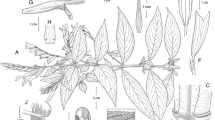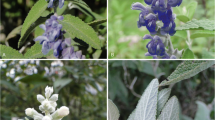Abstract
In this work, the taxonomic study of Salvinia from the southern and southeastern regions of Brazil is presented. We analyzed materials from herbaria BHCB, BHZB, CAY, CESJ, CVRD, DIAM, ESAL, FLOR, FUEL, FURB, HAS, HB, HBR, HUFU, HURG, ICN, MBM, MBML, OUPR, PACA, R, RB, SJRP, SP, SPF, SPFR, UEC, UPCB, VIC, VIES, plus online images of types, and field studies. In southern and southeastern Brazil, nine taxa of Salvinia occur, of which two are new to science: S. auriculata var. major C.V. Miranda & Schwartsb., var. nov., S. biloba Raddi, S. cucullata Roxb., S. × delasotae C.V. Miranda & Schwartsb., hybr. nov., S. herzogii de la Sota, S. oblongifolia Mart., S. minima Baker, S. molesta D.S. Mitch., and S. radula Baker. Salvinia cucullata and S. × delasotae are cultivated taxa, not occurring naturally. Based on studies of plants from French Guiana, we concluded that S. auriculata s. str. (= S. auriculata var. auriculata) does not occur in southern and southeastern Brazil. Updated nomenclatural headings, descriptions, illustrations, key, and maps of distribution of all taxa are also presented.





Similar content being viewed by others
References
Almeida GW (2009) Avaliação do potencial bioindicador e fitorremediador de Salvinia auriculata Aublet na presença de cádmio e chumbo. Master Thesis, Universidade Federal de Lavras, Lavras
Arana MD (2016) Família Salviniaceae Martinov. In: Anton AM, Zuloaga FO, Belgrano MJ, Ponce MM, Arana MD (eds) Flora vascular de la República Argentina 2: Licofitas, Helechos, Gymnospermae. Estudio Sigma S. R. L. and Instituto de Botánica Darwinion, Buenos Aires, pp 343–348
Baker JG (1886) A synopsis of the Rhizocarpeae. J Bot 24:97–101
Barthlott W, Wiersch S, Colic Z, Koch K (2009) Classification of trichome types within species of the water fern Salvinia, and ontogeny of the egg-beater trichomes. Botany 87:830–836. https://doi.org/10.1139/B09-048
Barthlott W, Schimmel T, Wiersch S, Koch K, Brede M, Barczewski M, Walheim S, Weis A, Kaltenmaier A, Leder A, Bohn HF (2010) The Salvinia paradox: superhydrophobic surfaces with hydrophilic pins for air retention under water. Adv Mater 22:2325–2328. https://doi.org/10.1002/adma.200904411
Chandra S (2007) The ferns of India (enumeration, synonyms & distribution). International Book Distributors, Dehra Dun
Christensen C (1906) Index filicum. H. Hagerup, Copenhagen
Croxdale JG (1978) Salvinia leaves. I. Origin and early differentiation of floating and submerged leaves. Can J Bot 56:1982–1991
Croxdale JG (1979) Salvinia leaves. II. Morphogenesis of the floating leaves. Can J Bot 57:1951–1959
Croxdale JG (1981) Salvinia leaves. III. Morphogenesis of the submerged leaf. Can J Bot 59:2065–2072
Fée ALA (1869) Cryptogames vasculaires du Brésil. Veuve Berger-Levrault & Fils, Strasbourg
Forno IW (1983) Native distribution of the Salvinia auriculata complex and keys to species identification. Aquat Bot 17:71–83
Forno IW, Harley KLS (1979) The occurrence of Salvinia molesta in Brazil. Aquat Bot 6:185–187
Herzog R (1935) Ein Beitrag zur Systematik der Gattung Salvinia. Hedwigia 74:257–284
Hijmans RJ, Guarino L, Bussink C, Mathur P, Cruz M, Barrentes I, Rojas E (2012) DIVA-GIS: a geographic information system for the analysis of species distribution data. Available at: http://www.diva-gis.org
IBGE (2012) Manual Técnico da Vegetação Brasileira. Série Manuais Técnicos em Geociências 1, 2nd edn. IBGE, Rio de Janeiro
Julien MH, Center TD, Tipping PW (2002) Floating Fern (Salvinia). In: Roy VD, Suzanne L, Bernd B, Mark H, Richard R (cords.). Biological Control of invasive plants in the Eastern United States. USDA Forest Service Puvlication, pp 17–32. Available at: https://www.invasive.org/biocontrol/
Khun M (1884) Isoëtaceae, Marsiliaceae, Salviniaceae. In: Martius CFP, Eichler AG (eds) Flora Brasiliensis. F. Fleischer, Leipzig, pp 646–662
Lellinger DB (2002) A modern multilingual glossary for taxonomic pteridology. Pteridologia 3. Amererican Fern Society, Austin
Martius CFP (1834) Icones plantarum cryptogamicarum. Munich
Mickel JT, Smith AR (2004) The Pteridophytes of Mexico. Mem New York Bot Gard 88:1–1030
Miranda CV, Schwartsburd PB (2016) Aquatic ferns from Viçosa (MG, Brazil): salviniales (Filicopsida; Tracheophyta). Braz J Bot 39:935–942. https://doi.org/10.1007/s40415-016-0284-9
Mitchell DS (1970) The autecology of Salvina auriculata Aubl. Ph.D. Dissertation, University of London, London
Mitchell DS (1972) The Kariba weed: Salvinia molesta. Br Fern Gaz 10:251–252
Mitchell DS (1978) Aquatic weeds in Papua New Guinea. Sci N Guinea 6:154–160
Mitchell DS, Thomas PA (1972) Ecology of waterweeds in the Neotropics. UNESCO Technical Papers in Hydrology 12
Mitchell DS, Tur NM (1975) The rate of growth of Salvinia molesta [S. auriculata Auct.] in laboratory and natural conditions. J Appl Ecol 12:213–225
Moran RC (1995) Salvinia Ség. In: Moran RC, Riba R (eds.). Psilotaceae a Salviniaceae. In: Davidse G, Souza M, Knapp S (general eds.). Flora Mesoamericana. Universidad Nacional Autónoma de México, Ciudad de México, vol 1, pp 395–396
Moran RC (2004) A natural history of ferns. Timber Press, Portland
Moran RC, Smith AR (1999) Salvinia adnata Desv. versus S. molesta D.S. Mitch. Am Fern J 89:268–269
Nagalingum NS, Schneider H, Pryer KM (2006) Comparative morphology of reproductive structures in heterosporous water ferns and a reevaluation of the sporocarp. Int J Plant Sci 167:805–815. https://doi.org/10.1086/503848
Nauman CE (1993) Salvinia. In: Flora of North America Editorial Committee. Flora of North America north of Mexico, vol. 2, Pteridophytes and Gymnosperms. Oxford University Press, New York, pp 336–338
Oliver JD (1993) A review of the biology of giant Salvinia. J Aquat Plant Manag 31:227–231
Pelosi BT, Lima LKS, Vieira MGA (2014) Caracterização da macrófita aquática Salvinia cucullata empregada na bioadsorção do corante sintétito Ácido Laranja 7.In: Blucher Chemical Engineering Proceedings 1. https://doi.org/10.5151/chemeng-cobec-ic-03-ts-078
Pereira PF, Antunes F, Braga VF, Resende CF, Ribeiro C, Peixoto PHP (2012) Pigmentos lipossolúveis e hidrossolúveis em plantas de salvínia sob toxicidade por cromo. Planta Daninha 30:697–703
Pott VJ, Pott A (2000) Plantas Aquáticas do Pantanal. Embrapa, Brasília
Ppg I (2016) A community-derived classification for extant lycophytes and ferns. J Syst Evol 54:563–603
Prado J, Sylvestre LS, Labiak PH, Windisch PG, Salino A, Barros ICL, Hirai RY, Almeida TE, Santiago ACP, Kieling-Rubio MA, Pereira AFN, Øllgaard B, Ramos CGV, Mickel JT, Dittrich VAO, Mynssen CM, Schwartsburd PB, Condack JPS, Pereira JBS, Matos FB (2015) Diversity of ferns and lycophytes in Brazil. Rodriguésia 66:1073–1083. https://doi.org/10.1590/2175-7860201566410
Raddi J (1819) Synopsis filicum brasiliensium. Opus Sci Bologna 3:279–297
Raddi J (1825) Plantarum Brasilensium nova genera. A. Pezzati, Florence, Pars I (Filices)
Room PM (1986) Equations relating growth and uptake of nitrogen by Salvinia molesta to temperature and the availability of nitrogen. Aquat Bot 24:43–59
Room PM, Thomas PA (1986) Nitrogen, phosphorus and potassium in Salvinia molesta Mitchell in the field: effects of weather, insect damage, fertilizers and age. Aquat Bot 24:213–232
Salino A, Almeida TE (2010) Salviniaceae. In: Forzza RC et al. (orgs.). Catálogo de Plantas e Fungos do Brasil. Andrea Jakobsson Studio, Jardim Botânico do Rio de Janeiro, Rio de Janeiro, vol1, pp 559–560
Schneller JJ (1980) Cytotaxonomic investigations of Salvinia herzogii de la Sota. Aquat Bot 9:279–283
Schneller JJ (1981) Chromosome number and spores of Salvinia auriculata Aublet s.str. Aquat Bot 10:81–84
Schwartsburd PB, Miranda CV (2017) Proposal to reject the name Salvinia adnata (Salviniaceae). Taxon 66:202–203. https://doi.org/10.12705/661.22
Sculthore CD (1967) The biology of aquatic vascular plants. E. Arnold, London
Séguier JF (1754) Plantae Veronensis seu stirpium quae in agro Veronensi reperiuntur methodica synopsis
Sehnem A (1979) Salviniáceas. In: REITZ PR (ed.). Flora Ilustrada Catarinense. Itajaí, Santa Catarina, fasc. SALV
Smith AR, Pryer KM, Schuettpelz E, Korall P, Schneider H, Wolf PG (2008) Fern classification. In: Ranker TA, Haufler CH (eds) Biology and evolution of ferns and lycophytes. Cambridge University Press, Cambridge, pp 417–467
Sota ER (1962a) Contribuicion al conocimiento de las Salviniaceae neotropicales, I. Salvinia oblongifolia Martius. Darwiniana 12:465–498
Sota ER (1962b) Contribuicion al conocimiento de las Salviniaceae neotropicales, II. Salvinia auriculata Aublet. Darwiniana 12:499–513
Sota ER (1962c) Contribuicion al conocimiento de las Salviniaceae neotropicales, III. Salvinia herzogii nov. spec.. Darwiniana 12:514–520
Sota ER (1982) Sobre Salvinia radula Baker (Salviniaceae–Pteridophyta). Biotica 7:457–461
Sota ER (1995) Nuevos sinónimos en Salvinia Ség. (Salviniaceae, Pteridophyta). Darwiniana 33:309–313
Sota ER (2001) Sobre el tipo de Salvinia adnata (Salviniaceae, Pteridophyta). Bol Soc Argent Bot 36:125–129
Sota ER, Cassa de Pazos LA (1992) Contribuicion al conocimiento de las Salviniaceae neotropicales, VI. Salvinia martynii. Darwiniana 31:315–320
Sota ER, Cassa de Pazos LA (2001) Two cytotypes and a new hybrid in Salvinia Séguier. Acta Amazon 31:557–564
Straube FC (2011) Ruínas e Urubus: História da Ornitologia no Paraná. Período Pré-Nattereriano (1541 a 1819). Hori Cadernos Técnicos 3, Curitiba
Tryon RM, Tryon AF (1982) Ferns and allied plants, with special reference to Tropical America. Springer, New York
Weatherby CA (1937) A further note on Salvinia. Am Fern J 27:98–102
Willdenow CL (1810) Species plantarum, 4th edn. G. C. Nauk, Berlin
Acknowledgements
The senior author thanks Coordenação de Aperfeiçoamento de Pessoal de Nível Superior (CAPES) for the fellowship. All authors would like to thank Programa de Pós-Graduação em Botânica (Universidade Federal de Viçosa) for partly paying the costs of this work, Reinaldo Pinto for the illustrations, and the following people for helping in the field and support: Nayara S. Smith-Braga, Fernanda L. Gotti, Andreza G. da Silva Oliveira, Laura S. Rabelo, Jaquelini Luber, Nelson Túlio L. Pena, Rosana Senna, Eduardo Guatimosim, Ana Rolon, Guilherme M. Naman, Márli de Souza, Ademir Reis, and Ronaldo Vinícius-Silva.
Author information
Authors and Affiliations
Contributions
CVM conceived and designed the experiments, performed the experiments, analyzed the data, wrote the paper. PBS conceived and designed the experiments, analyzed the data, wrote the paper.
Corresponding author
Ethics declarations
Conflict of interest
The authors declare there are no competing interests.
Additional information
Publisher's Note
Springer Nature remains neutral with regard to jurisdictional claims in published maps and institutional affiliations.
Rights and permissions
About this article
Cite this article
Miranda, C.V., Schwartsburd, P.B. Salvinia (Salviniaceae) in southern and southeastern Brazil—including new taxa, new distribution records, and new morphological characters. Braz. J. Bot 42, 171–188 (2019). https://doi.org/10.1007/s40415-019-00522-5
Received:
Accepted:
Published:
Issue Date:
DOI: https://doi.org/10.1007/s40415-019-00522-5




